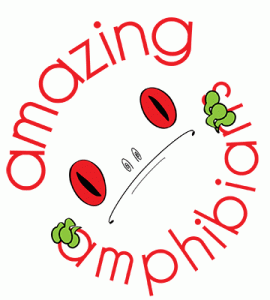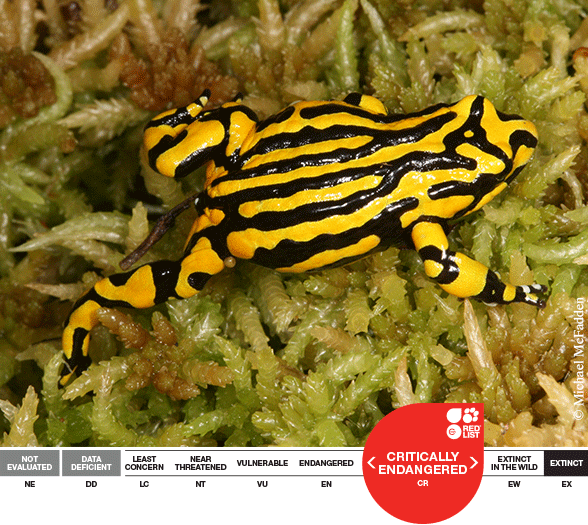 The bright yellow and black stripes make Southern Corroboree Frog, Pseudophryne corroboree, one of the most striking of all Australian frogs. This spectacular-looking species is listed as ‘Critically Endangered’ on the IUCN Red List of Threatened SpeciesTM due to a dramatic population decline over the past thirty years, and a projected further decline in its limited habitat. The current wild population size is thought to be less than 50 individuals. The distribution of the species is limited to the Snowy Mountains of southeastern New South Wales, Australia, in the Kosciuszko National Park, where it is restricted to montane and subalpine woodlands and grasslands above 1,300 meters elevation.
The bright yellow and black stripes make Southern Corroboree Frog, Pseudophryne corroboree, one of the most striking of all Australian frogs. This spectacular-looking species is listed as ‘Critically Endangered’ on the IUCN Red List of Threatened SpeciesTM due to a dramatic population decline over the past thirty years, and a projected further decline in its limited habitat. The current wild population size is thought to be less than 50 individuals. The distribution of the species is limited to the Snowy Mountains of southeastern New South Wales, Australia, in the Kosciuszko National Park, where it is restricted to montane and subalpine woodlands and grasslands above 1,300 meters elevation.
 |
Their susceptibility to chytrid fungus and the effects of climate change are thought to be the major threats facing the Southern Corroboree Frog. Between 16-40 eggs are laid in the summer months in a “nest” made within moss or other soft vegetation and they hatch after 4-6 months when the nests are usually flooded by rain. The tadpoles then develop into froglets in pools adjacent to the nest area.
A National Recovery Plan was developed for the Southern Corroboree Frog in 1996 and this has subsequently been revised and updated. The main actions recommended by the recovery plan include population monitoring, captive breeding for release, and developing methods for mitigating chytrid fungus. Captive breeding and rearing programs are active at Taronga Zoo in New South Wales, and at Melbourne Zoo, Healesville Sanctuary and the Amphibian Research Centre in Victoria. Since 2005, captive-reared eggs and adult frogs have been released back into the wild, and more recently, releases of eggs have been undertaken into artificial pools which are free of chytrid fungus, thereby avoiding tadpoles potentially being infected by the fungus during their most vulnerable growth stages. Scientists also are hoping to develop new chytrid-free wild populations. If current recovery efforts are not successful, the species faces extinction in the wild within the next 5-10 years.
Submit your observations of this species to iNaturalist and they will appear on this map. Learn more about this species on Amphibiaweb.
More Amazing Amphibians here.
Produced in partnership with:
Senior Partners |
|||
 |
 |
 |
|
 |
|||
Focal Partners |
|
 |
|
Affiliates |
|||
 |
 |
||
 |
|||
How to become an Amazing Amphibians partner:
Outlined below are the roles and responsibilities for the 4 different levels of involvement for potential partners. If your organization would like to be a part of the Amazing Amphibians program in either of these capacities please email amazing@amphibians.org.
Senior Partner – These partners will help with multiple aspects of the program, help facilitate the completion of several species profiles, publicize each Amazing Amphibian and will likely have a landing page for the program on their website. This level of partner will be leading in using their communication channels to gather additional information for the program such as images and data points for iNaturalist.
Strategic Partner – These partners will play an active role in creating species profiles, submitting at least three species profiles per year and actively use their social network to publicize each Amazing Amphibian. This level of partner will be active in using their communication channels to gather additional information for the program such as images and data points for iNaturalist.
Focal Partner – Partners tend to be active in a limited geographic area. This partner will submit at least one regional species profile per year and use their social network to publicize each Amazing Amphibian. This level of partner will be involved in using their communication channels to gather additional information at a regional level for the program such as images and data points for iNaturalist.
Affiliate – These partners are interested in promoting the program but might not be in a position to provide profiles. These partners will publicize each Amazing Amphibian through the social media outlets.







